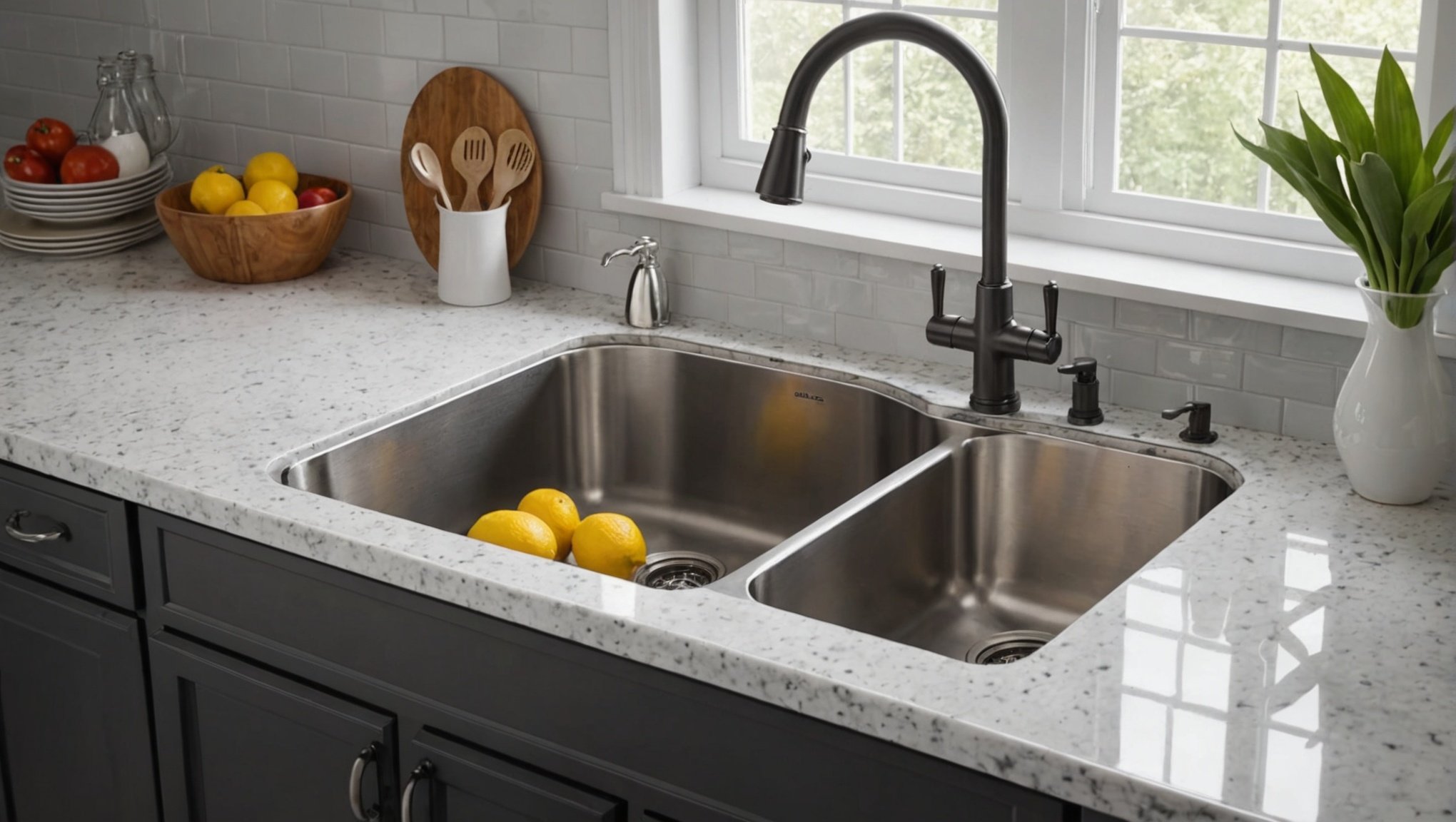Choosing a heavy-duty kitchen sink requires more than just aesthetics; it demands understanding your needs and kitchen dynamics. Consider material durability, size, and configuration that fits your workflow. Assessing installation requirements and ease of maintenance can save time and hassle later. This comprehensive guide unpacks all essential aspects, empowering you to make an informed choice that will endure the rigors of daily use while enhancing your kitchen functionality.
Key Features of Heavy-Duty Kitchen Sinks
Exploring the essential aspects of durable and functional sinks.
Topic to read : Designing a Kitchen That Fuels Your Active Lifestyle: Tips for Health and Efficiency
Material Options for Heavy-Duty Sinks
The durability of a kitchen sink largely depends on the materials used. Stainless steel, cast iron, and granite composite are popular choices for heavy-duty kitchen sinks. Each offers unique benefits:
- Stainless Steel: Resists rust and stains, offering a sleek look.
- Cast Iron: Known for its strength, with a glossy enamel finish.
- Granite Composite: Provides a modern appearance and scratch resistance.
Choosing the right material enhances both sink durability and aesthetic appeal.
Also read : Designing the Perfect Kitchen Layout for Effortless Batch Cooking Success
Design Features That Enhance Functionality
Design plays a crucial role in a sink's functionality. Features such as integrated drainboards, soundproofing pads, and multiple basins can significantly improve kitchen efficiency. Consider a sink with:
- Integrated drainboards for easy drying.
- Soundproofing to minimize noise.
- Multiple basins for multitasking.
These elements contribute to a more efficient and pleasant kitchen experience.
Importance of Sink Depth and Size
The depth and size of a sink are vital for its functionality. A deeper basin accommodates larger pots and pans, while a wider sink offers more space for washing. A heavy-duty kitchen sink should balance durability and practicality, ensuring it meets the demands of a busy kitchen.
Pros and Cons of Heavy-Duty Kitchen Sinks
Weighing the benefits and drawbacks of robust sink options.
Advantages of Heavy-Duty Sinks
Long-term durability is a significant advantage of heavy-duty kitchen sinks. Made from materials like stainless steel and granite composite, these sinks withstand daily wear and tear, maintaining their appearance over time. A heavy-duty sink often requires less frequent replacement, making it a cost-effective choice in the long run.
Maintenance is typically straightforward. Stains and scratches are less noticeable, especially in materials like granite composite. This reduces the need for intensive cleaning, saving time and effort.
Disadvantages of Heavy-Duty Sinks
However, there are some disadvantages to consider. The initial cost of heavy-duty options can be higher than standard sinks. This upfront investment may not suit all budgets, despite the long-term savings.
In terms of aesthetic implications, heavy-duty sinks can sometimes dominate a kitchen's design. Their robust appearance might not align with every style preference, potentially limiting design flexibility.
Bulleted List of Considerations:
- Durability: Long-lasting but expensive.
- Maintenance: Easy but requires initial care.
- Aesthetic: Bold but potentially restrictive.
Balancing these pros and cons helps homeowners make informed decisions about integrating a heavy-duty kitchen sink into their space.
Installation Tips for Heavy-Duty Kitchen Sinks
Ensuring a smooth and successful installation process.
Recommended Tools and Materials
Proper kitchen sink installation requires specific tools and materials to ensure a secure fit. Essential items include a wrench, plumber's putty, silicone sealant, and a level. Having these ready can streamline the process, minimizing disruptions.
Step-by-Step Installation Process
- Preparation: Measure the sink area to ensure the new sink fits. Shut off water supply and disconnect plumbing.
- Mounting: Choose the appropriate sink mounting options—drop-in or undermount. Apply plumber's putty around the sink's edge or use brackets for undermount.
- Securing: Place the sink, ensuring it's level. Tighten mounting clips or secure brackets.
- Sealing: Apply silicone sealant around the edges to prevent leaks.
- Reconnection: Reconnect plumbing and check for leaks.
Common Pitfalls to Avoid
Avoid these common mistakes during kitchen sink installation:
- Skipping measurements can lead to improper fit.
- Ignoring sealant application risks water damage.
- Over-tightening clips may damage the sink.
By following these guidelines and avoiding pitfalls, you can achieve a successful and efficient installation of your heavy-duty kitchen sink.
Top Brands of Heavy-Duty Kitchen Sinks
Exploring the leading manufacturers in the industry.
Brand Overview
When considering the best heavy-duty sink brands, it's crucial to compare features and user satisfaction. Notable names in the market include Kohler, Blanco, and Elkay. These brands are renowned for their durability and innovative designs, making them popular choices for homeowners seeking robust kitchen solutions. Each offers a distinct range of products that cater to various style preferences and functional needs.
Product Range and Features
The product range of these brands showcases diverse options. Kohler is known for its elegant, stainless steel sinks, while Blanco offers granite composite models that emphasize scratch resistance. Elkay provides versatile designs with integrated features like soundproofing and multiple basins. These features enhance usability, making everyday kitchen tasks more manageable and efficient.
User Ratings and Reviews
User ratings and reviews play a significant role in choosing the right sink. Customers often praise the durability and low maintenance of these brands. However, some reviews highlight the higher initial cost as a potential drawback.
- Kohler: Highly rated for design and functionality.
- Blanco: Appreciated for its modern look and resilience.
- Elkay: Valued for versatility and practical features.
By considering these factors, homeowners can make informed decisions about the best heavy-duty sink brands.
Maintenance and Care for Heavy-Duty Kitchen Sinks
Ensuring longevity through proper care and maintenance.
Recommended Cleaning Products and Techniques
To maintain the durability of your heavy-duty kitchen sink, use non-abrasive cleaning products. For stainless steel sinks, a mixture of water and baking soda can effectively remove stains without scratching. Granite composite sinks benefit from mild dish soap and warm water, ensuring their modern appearance remains intact. Always dry the sink after cleaning to prevent water spots.
Regular Maintenance Practices to Extend Lifespan
Regular maintenance is key to extending the lifespan of your sink. Ensure that you routinely check for any signs of wear or damage, such as scratches or stains. Cleaning should be performed weekly, focusing on hard-to-reach areas. Use a soft cloth to polish and maintain the sink's finish.
- Weekly cleaning routine
- Monthly inspection for damage
- Polish stainless steel regularly
Addressing Common Issues and Repairs
Common issues with heavy-duty sinks include minor scratches or dull finishes. For stainless steel, use a specialized polish to buff out scratches. If your granite composite sink develops stains, a vinegar solution can help restore its look. Regular maintenance prevents these issues from escalating, ensuring your sink remains a functional and aesthetic asset in your kitchen.











